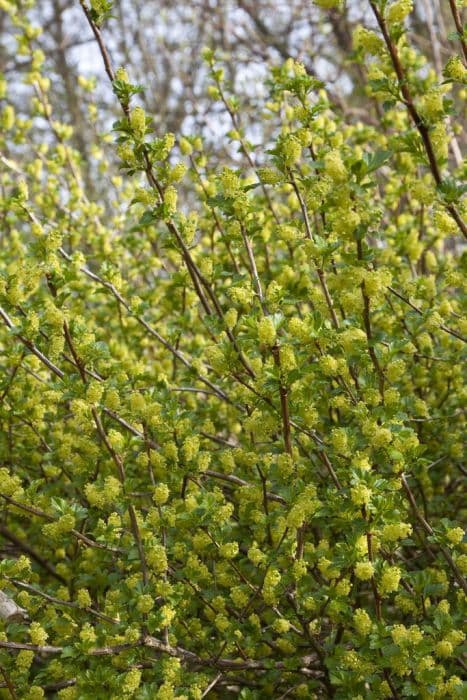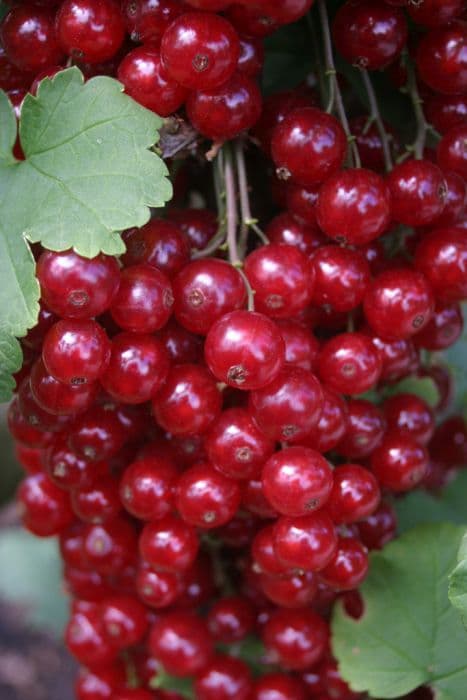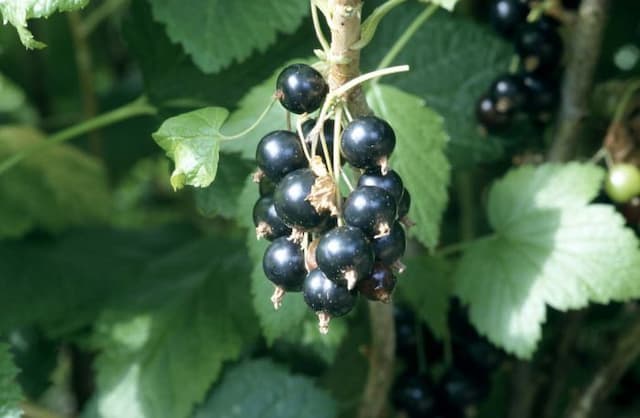Red currant Ribes rubrum 'Jonkheer van Tets' (R)

ABOUT
The 'Jonkheer van Tets' is a popular variety of red currant, known for its vibrant, glossy red berries that hang in clusters from the plant. This deciduous shrub has a bushy nature with multiple upright stems. The leaves of the red currant are typically a bright green, with a subtle sheen and a lobed appearance, resembling a rough maple leaf shape. They are arranged alternately along the branches. During the spring, the plant produces modest, yet numerous flowers. These are small and arranged in racemes, which are hanging clusters that later develop into the fruit for which the plant is known. The flowers are generally greenish-yellow or sometimes have a reddish tinge. As summer progresses, the berries ripen to a deep red and are typically ready for harvest in early to mid-summer. The berries are juicy and tart, making them a favorite for culinary uses, such as in jellies, sauces, and baked goods. The juxtaposition of the bright fruit against the foliage creates an attractive display that can be both ornamental and practical for gardeners who appreciate both beauty and yield in their plant selections.
About this plant
 Names
NamesSynonyms
Red Currant, Jonkheer van Tets Currant.
Common names
Ribes rubrum 'Jonkheer van Tets'.
 Toxicity
ToxicityTo humans
Red currant (Ribes rubrum 'Jonkheer van Tets') is generally considered non-toxic to humans, and its berries are edible and commonly consumed. There is no widespread report of poisoning or toxic reactions from consuming the berries or other parts of the red currant in normal food quantities. It's important, however, to ensure that the plant has not been treated with pesticides or other chemicals that could be harmful if ingested.
To pets
Red currant is typically safe for pets as well, and there are no known toxic effects of this plant on common domestic animals such as cats and dogs. The berries of the red currant can be eaten in moderation by pets without the expectation of adverse symptoms. Nevertheless, it is always best to exercise caution and prevent pets from eating large quantities of any non-traditional foods to avoid gastrointestinal upset.
 Characteristics
CharacteristicsLife cycle
Perennials
Foliage type
Deciduous
Color of leaves
Green
Flower color
Greenish-yellow
Height
4-6 feet (1.2-1.8 meters)
Spread
4-5 feet (1.2-1.5 meters)
Plant type
Shrub
Hardiness zones
3-8
Native area
Europe
Benefits
 General Benefits
General Benefits- Edible Fruit: Red currants are a rich source of vitamins and provide a fresh, tart flavor that can be enjoyed fresh or used in culinary preparations such as jellies, syrups, and desserts.
- Attracts Wildlife: The plant’s flowers attract bees and butterflies, while the fruit provides food for birds, contributing to ecosystem health.
- Landscape Ornamentation: Ribes rubrum 'Jonkheer van Tets' offers ornamental value with its bright red berries and attractive foliage, making it a popular choice for gardens.
- Easy to Grow: This particular cultivar is known for being hardy and easy to grow, requiring minimal maintenance once established in the proper conditions.
- Seasonal Interest: It provides visual interest throughout the growing season with flowers in spring, fruit in summer, and foliage that changes color in the fall.
- Cold Hardy: Ribes rubrum 'Jonkheer van Tets' is resistant to cold temperatures, making it suitable for growing in cooler climates.
- Compact Growth: The plant has a compact growth habit, which makes it ideal for smaller gardens or for growing in containers.
- Soil Versatility: It can thrive in a range of soil types, although it prefers well-drained, fertile soil, making it adaptable to various garden settings.
 Medical Properties
Medical Properties- Antioxidant: Red currant berries contain vitamin C and other antioxidants that may help in protecting cells from oxidative damage.
- Anti-inflammatory: Some compounds present in red currants can have anti-inflammatory effects, which might be beneficial in reducing inflammation-related conditions.
- Gastrointestinal Health: The fiber content in red currants can aid in digestion and prevent constipation.
- Immune Support: The vitamin C content also contributes to the support of the immune system.
 Air-purifying Qualities
Air-purifying QualitiesThis plant is not specifically known for air purifying qualities.
 Other Uses
Other Uses- Wildlife Habitat: The red currant bush provides shelter and nesting sites for various birds and small mammals.
- Dye Production: The berries can be used to produce a natural dye for textiles or crafts.
- Photography Subject: Red currant plants, with their bright berries and delicate flowers, are often used as subjects in botanical photography.
- Edible Landscaping: As an ornamental plant, it adds aesthetic value to gardens while yielding edible fruit.
- Windbreaks: When planted in rows, red currant bushes can act as windbreaks, protecting other plants in the garden.
- Beekeeping Support: The flowers of red currant plants provide a good source of nectar for bees early in the season.
- Cooking Workshops: The plant can be used in educational settings to teach jam and jelly making.
- Erosion Control: The plant's root system can help to prevent soil erosion on banks and slopes.
- Holiday Decor: The branches with attached berries can be used for wreaths and other festive decorations.
- Culinary Events: Red currants from the plant can be featured in food festivals and restaurant menus, celebrating local produce.
Interesting Facts
 Feng Shui
Feng ShuiThe red currant is not used in Feng Shui practice.
 Zodiac Sign Compitability
Zodiac Sign CompitabilityThe red currant is not used in astrology practice.
 Plant Symbolism
Plant Symbolism- Fertility: As the Ribes rubrum 'Jonkheer van Tets', commonly known as redcurrant, bears fruit abundantly, it is often associated with fertility and plenty.
- Vitality: The vibrant red color of its berries represents life and vitality, symbolizing energy and health.
- Prosperity: The plentiful nature of the redcurrant's harvest can also symbolize prosperity and wealth, both material and spiritual.
- Joy and Gratification: The sweet and slightly tart taste of the berries signifies the complex mix of experiences in life, with an emphasis on sweetness and joy.
- Protection: In some cultures, red berry-bearing plants like redcurrant are thought to offer protection against negative energies and misfortune.
 Water
WaterFor the red currant 'Jonkheer van Tets', it's important to water regularly to maintain evenly moist soil, especially during dry spells. Water deeply once a week with about 1 to 1.5 gallons of water, depending on rainfall and soil conditions. In hot climates or during periods of drought, you may need to increase watering to twice per week. Monitor the soil moisture by checking a few inches below the surface – the soil should feel moist but not waterlogged. During the winter dormant period, reduce watering since the plant's water requirements will decrease.
 Light
LightThe red currant 'Jonkheer van Tets' thrives best in full sun to partial shade. Planting in a spot that receives at least 4-6 hours of direct sunlight a day will ensure good fruit production and plant health. Avoid placing the plant in deep shade, as this can reduce flowering and fruiting.
 Temperature
TemperatureThe red currant 'Jonkheer van Tets' performs well in a wide range of temperatures, but the ideal temperature range for growing is between 60 to 75 degrees Fahrenheit. It is hardy and can withstand winter temperatures down to about -40 degrees Fahrenheit, making it suitable for northern climates. During the growing season, ensure that the plant is not exposed to prolonged temperatures above 85 degrees Fahrenheit, which can stress the plant.
 Pruning
PruningPruning the red currant 'Jonkheer van Tets' is essential for maintaining plant health and encouraging fruit production. Prune in late winter or early spring before new growth begins, removing dead or damaged wood and thinning out old branches to allow light and air to reach the center of the plant. This encourages new growth, which is where the fruit will form. Prune annually to keep the plant productive and well-shaped.
 Cleaning
CleaningAs needed
 Soil
SoilRibes rubrum 'Jonkheer van Tets', commonly known as red currant, thrives best in a well-drained, fertile loam with a pH between 6.0 and 6.5. A mixture of garden soil, compost, and peat or a well-rotted manure can provide the appropriate nutrients and structure. Adding perlite or sand improves drainage.
 Repotting
RepottingRed currants, such as 'Jonkheer van Tets', do not typically require frequent repotting and are generally planted directly in the ground. However, if grown in containers, repotting every 2-3 years or when roots become pot-bound ensures healthy growth.
 Humidity & Misting
Humidity & MistingRed currants like 'Jonkheer van Tets' prefer outdoor conditions with natural humidity. They do not require high humidity environments; average outdoor humidity is sufficient for their growth.
 Suitable locations
Suitable locationsIndoor
Provide bright light, cool temps, good air circulation.
Outdoor
Full sun, protect from strong winds, mulch root area.
Hardiness zone
3-7 USDA
 Life cycle
Life cycleThe Red Currant 'Jonkheer van Tets' begins its life cycle when seeds germinate in moist soil conditions, leading to the emergence of seedlings. These seedlings develop into young plants with a root system, stems, and leaves, entering the vegetative growth stage. The plant matures and reaches the flowering stage, typically around spring, when it produces clusters of small, greenish-white flowers that are pollinated by insects. After pollination, the flowers develop into bright red berries, which ripen in mid to late summer and are the reproductive fruiting stage of the plant. Once the fruit is either dispersed by animals or falls to the ground, seeds may germinate, continuing the cycle. The plant enters dormancy in winter, with leaf fall and cessation of active growth, ensuring survival until the conditions become favorable again in spring.
 Propogation
PropogationPropogation time
Spring-Early Summer
The red currant 'Jonkheer van Tets' can be most effectively propagated through hardwood cuttings. This process is best carried out in late fall after the leaves have dropped, or in early winter. To propagate, you would take hardwood cuttings of about 6 to 8 inches (15 to 20 centimeters) in length from healthy, mature stems. Make a straight cut at the base just below a bud, and a slanted cut at the top just above a bud to encourage water runoff and differentiate the top from the bottom. The cuttings should be planted in moist, well-drained soil, ensuring at least two buds are below the surface with several above. Roots and shoots will begin to develop in the spring.



![Flowering currant [White Icicle]](/_next/image?url=https%3A%2F%2Fplants-admin.emdemapps.com%2Fimages%2Fplants%2F%2Fimages%2F604b5fe15ab5b.png&w=640&q=75)




